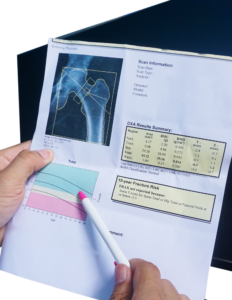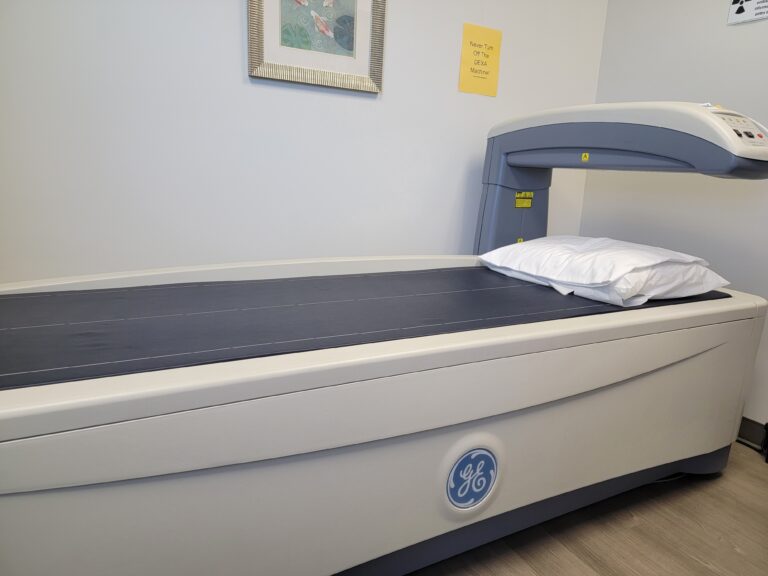As women navigate through the transformative phase of perimenopause, characterized by hormonal fluctuations and very real physical changes, the importance of prioritizing health and preventative measures becomes paramount. Multiple changes are happening in our bodies during perimenopause, some of these changes you can see in the mirror, but most are invisible to the naked eye.
One of these hidden risks is bone density loss. Women typically have lower peak bone mass than men, and the decline in estrogen levels during perimenopause accelerates bone loss. Women can lose up to one-fifth of their bone density during their perimenopausal years. This is a huge decline that often goes unnoticed until it is too late. This reduction in bone density increases the risk of fractures, particularly in weight-bearing bones such as the hips and spine.
I am an active woman navigating perimenopause myself. I understand the risk factors and am a big believer in preventive measures rather than the treatment of a disease. Working with perimenopausal and menopausal women I make it a priority to share my knowledge and expertise and tailor their training to offset and stall the changes associated with flattening of the main sex hormones.
One of the preventative measures that any woman can take is to request a DEXA scan. Dual-energy X-ray absorptiometry (DEXA) scans are crucial in assessing and safeguarding the bone health of perimenopausal women.
It took me a while to find a place where they would do the scan as most places refused, saying I was too young. But there are places out there if you look hard enough. Screening is recommended for women aged 65 and older. By waiting that long to do the scan, it may be too late. Once the damage is done, there is no way to grow lost bone back. Also, this approach does not provide any baseline number to assess against and see how fast or slow the process is occurring. Most insurance does not cover the scan until the age or risk factors are met but you can use your HSA/FSA money to pay for the scan yourself.
When the results came in, I was in complete shock to learn that I had osteopenia at the age of 46. Osteopenia is a precursor to osteoporosis, a more severe condition characterized by significantly reduced bone density and an increased risk of fractures.
Looking back, maybe I should not have been that surprised. In 2023 I competed in the Ironman World Championships in Kona, Hawaii and a few days before the race, I collided with another swimmer during our open water swim practice. The result – a broken finger from an impact that should not have caused a broken bone. I did not think much of it at that time and finished the race wearing a splint but now I realize it should have been my wake-up call.
Why Do Perimenopausal Women Need DEXA Scans:
1. Early Detection of Bone Loss: DEXA scans offer a non-invasive and accurate way to assess bone mineral density. Detecting early signs of bone loss during perimenopause allows for timely interventions to prevent further deterioration.
2. Risk Assessment for Osteoporosis: Perimenopausal women are at an increased risk of developing osteoporosis. DEXA scans provide a personalized risk assessment, helping healthcare professionals tailor strategies to mitigate this risk based on individual bone health.
3. Guiding Preventive Measures: Armed with DEXA scan results, healthcare providers can guide perimenopausal women on lifestyle modifications, dietary changes, and exercise regimens to promote bone health and reduce the risk of fractures.
4. Monitoring Hormonal Changes: Hormonal fluctuations during perimenopause can impact bone metabolism. DEXA scans enable monitoring of bone density changes, facilitating a better understanding of the effects of hormonal shifts on bone health.
5. Customized Treatment Plans: Should the DEXA scan reveal lower than optimal bone density, healthcare providers can develop personalized treatment plans. These may include calcium and vitamin D supplementation, hormone replacement therapy, or other medications aimed at strengthening bones.
6. Fracture Prevention: By identifying individuals with low bone density, DEXA scans help in implementing preventive measures to reduce the risk of fractures, particularly those associated with osteoporosis.

So how am I going to modify my daily life now, when I have the results of my DEXA scan?
* Focus even more on my resistance training
* Include regular balance training
* Include regular plyometric training
* Order my blood work
* Add Vitamin D supplementation
* Add Calcium supplementation
* Implement regular monitoring strategies before insurance approved age 65
* Add weighted vest walking/hiking into my exercise routine
These measures are specific to me in my particular case. Treatment and/or preventative measures for any medical condition should be done with the assistance and advice of medical professionals.
Bone health is vital to all humans, and perimenopause is a pivotal juncture where proactive measures can make a significant difference. DEXA scans emerge as invaluable tools, offering insights into bone density, guiding preventive strategies, and enabling personalized care plans. As perimenopausal women navigate this transformative phase, prioritizing bone health through DEXA scans becomes a proactive and empowering step towards a healthier, more resilient future. Consultation with healthcare professionals to discuss the need for a DEXA scan and the subsequent implementation of tailored interventions can pave the way for a journey marked by strong and resilient bones.




